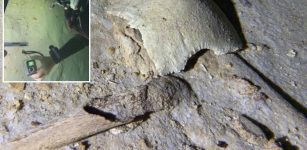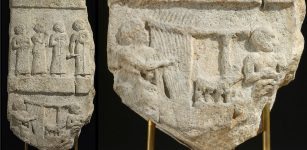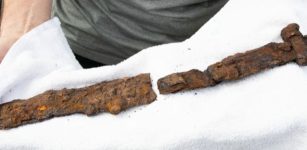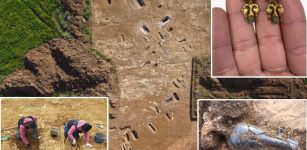Lady Midday – ‘Poludnica’- An Evil, Elusive Female Field-Spirit In Slavic Beliefs That Comes To Kill At Noon
A. Sutherland - AncientPages.com - In Slavic mythology, a figure known as "Lady Midday," also referred to as "Midday Spirit" or "Poludnica," is a female noon devil. She cis lassified as a malevolent creature in folklore.
Statue of the Midday Maiden in Spreewald (Blota), Lusatia. Image credit: Qualia - CC BY-SA 3.0
According to traditional beliefs, she poses a significant threat to individuals who venture to work in the fields during hot days.
The legend suggests that encountering Lady Midday under these circumstances could result in severe consequences, potentially even fatal ones. This mythological figure serves as a cautionary tale within Slavic cultural traditions, highlighting the perceived dangers associated with midday labor in agricultural settings.
We must be aware of her presence on a hot summer day and not challenge her by engaging in extreme, exhausting activities that could seriously risk our lives.
Appearance Of Evil Midday Spirit
In ancient Slavic beliefs, she usually takes many different forms. She can appear as a strong air vortex during hot summer days and whirling dust clouds. In Moravia, one of the historical Czech lands, the Lady Midday is imagined as an older woman clad in a white dress with an ugly face, slanting eyes, and ruffled hair.
In Polish and other Slavic ancient beliefs, this mythological figure is described with specific characteristics. The Lady Midday is typically portrayed as a tall female figure, adorned in a full-length white robe. She is said to carry two distinct items: a sharp sickle, which is believed to cause instant death, and a large sack on her back. The sack's purpose, according to legend, is to capture unattended children in fields during harvest time.
In other descriptions, she is sometimes depicted as a woman with pale skin, dressed in white, with long, flowing hair. It's important to note that while this appearance might seem benign or even attractive at first glance, it is considered a deceptive facade. In reality, the legends describe her as an aged, unattractive being with malevolent intentions.
This mythological figure serves as an example of how ancient beliefs often incorporated elements of danger and deception into their supernatural entities, possibly as a means to explain natural phenomena or to reinforce cultural norms and behaviors.
During the summer months, Poludnica can be found in fields and wooded areas, where it observes individuals engaged in strenuous labor under the hot sun. Additionally, it is known that she can appear within cottages during stormy weather conditions. This behavior pattern is consistent across various reported sightings and folklore accounts.
Lady Midday Is Never Reluctant To Kill
Farmers and laborers also attribute this field spirit to natural phenomena such as strikingly vivid mirages known as fata morgana.
Traditionally, Poludnica operates only at noon during scorching summer days. On smaller farms with minimal mechanization, harvesting is the most labor-intensive activity of the growing season. This evil creature is aware of it and patiently waits until a farmer feels dizziness and weakness in his body, and then she attacks.
This demon is never reluctant to kill, and if she encounters a resting or sleeping man in the sun, not covered by any shadow, she suffocates them or scalds him painfully.
How Can We Protect Ourselves From Lady Midday?
In ancient times, people believed they could protect themselves from the dangerous Lady Midday.
Poludnica - evil Slavic spirit. Image credit: Nadezhda Antipova - H. Grushko, Y. Medvedev (A Dictionary of Slavic mythology — Nizhny Novgorod: 'Russian merchant' and 'Brothers Slavs', 1996 via Wikipedia
A very efficient way was to avoid hard work during the hottest part of the day, try to stay in a shadow as long as possible, or return home.
Lady Midday – Personification Of Natural Phenomenon
Ancient people did not fully understand natural phenomena and blamed Lady Midday for the harm caused by the sun's extreme heat.
She was probably identified with summer whirls, which frequently occurred on hot days before the approaching storm. Today, we understand that this sudden weather change arises and then disappears as quickly as it appears.
It is also possible that heat illness due to an exposure to heat that is widely known in modern science as 'sunstroke' was by ancient people explained as the evil attack by Poludnica – the Lady Midday.
Written by – A. Sutherland - AncientPages.com Senior Staff Writer
Updated on July 5, 2024
Copyright © AncientPages.com All rights reserved. This material may not be published, broadcast, rewritten or redistributed in whole or part without the express written permission of AncientPages.com
More From Ancient Pages
-
 Young Boy Finds Unique Micro-Mosaic Cross Medallion In Jerusalem
Archaeology | Jan 3, 2025
Young Boy Finds Unique Micro-Mosaic Cross Medallion In Jerusalem
Archaeology | Jan 3, 2025 -
 Nebuchadnezzar II – Greatest Ruler Of Ancient Babylonia And Conqueror Of Judah
Featured Stories | Jan 28, 2019
Nebuchadnezzar II – Greatest Ruler Of Ancient Babylonia And Conqueror Of Judah
Featured Stories | Jan 28, 2019 -
 Legendary Grianán Of Aileach Built By God Dagda Of Tuatha De Danann Was Once The Royal Seat Of The Kingdom Of Ailech
Featured Stories | May 13, 2021
Legendary Grianán Of Aileach Built By God Dagda Of Tuatha De Danann Was Once The Royal Seat Of The Kingdom Of Ailech
Featured Stories | May 13, 2021 -
 King Solomon’s Magical Shamir Could Cut Through Any Stone – Proof Of Advanced Ancient Technology?
Featured Stories | Aug 23, 2018
King Solomon’s Magical Shamir Could Cut Through Any Stone – Proof Of Advanced Ancient Technology?
Featured Stories | Aug 23, 2018 -
 Mysterious Kola Pyramids Built By An Unknown Lost Ancient Civilization Can Rewrite Ancient History
Civilizations | Aug 3, 2020
Mysterious Kola Pyramids Built By An Unknown Lost Ancient Civilization Can Rewrite Ancient History
Civilizations | Aug 3, 2020 -
 8,000 Year-Old Human Skeleton Discovered By Cave Divers Near Tulum, Mexico
Archaeology | Sep 15, 2022
8,000 Year-Old Human Skeleton Discovered By Cave Divers Near Tulum, Mexico
Archaeology | Sep 15, 2022 -
 On This Day In History: Ruler Of Palenque Yohl Ik’nal Was Crowned – On Dec 23, 583
News | Dec 23, 2016
On This Day In History: Ruler Of Palenque Yohl Ik’nal Was Crowned – On Dec 23, 583
News | Dec 23, 2016 -
 Archaeological Evidence Of Human Presence In America 250,000 Years Ago?
Featured Stories | Mar 5, 2024
Archaeological Evidence Of Human Presence In America 250,000 Years Ago?
Featured Stories | Mar 5, 2024 -
 The Name Vatican And Etruscan Goddess Vatika Of The Underworld – What Is The Connection?
Featured Stories | Jun 6, 2020
The Name Vatican And Etruscan Goddess Vatika Of The Underworld – What Is The Connection?
Featured Stories | Jun 6, 2020 -
 Amazing Archaeological Discovery In Washington Confirms Thousand-Year-Old Legend
Featured Stories | Jul 7, 2024
Amazing Archaeological Discovery In Washington Confirms Thousand-Year-Old Legend
Featured Stories | Jul 7, 2024 -
 Mesopotamian Music Stele That Commemorates Gudea King Of Lagash In Temple Foundation Ceremony
Artifacts | Dec 12, 2016
Mesopotamian Music Stele That Commemorates Gudea King Of Lagash In Temple Foundation Ceremony
Artifacts | Dec 12, 2016 -
 On This Day In History: Unbelievable Flight Took Place – On Apr 28, 1939
News | Apr 28, 2016
On This Day In History: Unbelievable Flight Took Place – On Apr 28, 1939
News | Apr 28, 2016 -
 Why Have The Leibniz Keks 52 Teeth And Are Named After Philosopher Gottfried Wilhelm Leibniz?
Ancient History Facts | Mar 12, 2021
Why Have The Leibniz Keks 52 Teeth And Are Named After Philosopher Gottfried Wilhelm Leibniz?
Ancient History Facts | Mar 12, 2021 -
 Man Finds A Viking Sword In His Garden – A Viking Grave Could Also Be Nearby – Scientists Say
Archaeology | Sep 2, 2022
Man Finds A Viking Sword In His Garden – A Viking Grave Could Also Be Nearby – Scientists Say
Archaeology | Sep 2, 2022 -
 Bacho Kiro Cave: Genomes Of The Earliest Europeans – Sequenced
Archaeology | Apr 8, 2021
Bacho Kiro Cave: Genomes Of The Earliest Europeans – Sequenced
Archaeology | Apr 8, 2021 -
 An Intact 4,000-Year-Old Burial Chamber Found In Aswan
Archaeology | Mar 28, 2017
An Intact 4,000-Year-Old Burial Chamber Found In Aswan
Archaeology | Mar 28, 2017 -
 Incredible Roman Necropolis With Dressed Skeletons Buried In Ornate Tombs Discovered Close To The Ancient City Of Tarquinia
Archaeology | Jan 9, 2024
Incredible Roman Necropolis With Dressed Skeletons Buried In Ornate Tombs Discovered Close To The Ancient City Of Tarquinia
Archaeology | Jan 9, 2024 -
 Neanderthals Had Older Mothers And Younger Fathers Compared To Modern Humans
Archaeology | Apr 23, 2020
Neanderthals Had Older Mothers And Younger Fathers Compared To Modern Humans
Archaeology | Apr 23, 2020 -
 Unexplained Disappearance Of East Balkan Civilizations – Discovery Of Unusual Mini Artifacts – Part 1
Ancient Mysteries | Apr 28, 2018
Unexplained Disappearance Of East Balkan Civilizations – Discovery Of Unusual Mini Artifacts – Part 1
Ancient Mysteries | Apr 28, 2018 -
 On This Day In History: Treaty Of Picquigny – Negotiations Between England And France – On Aug 29, 1475
News | Aug 29, 2017
On This Day In History: Treaty Of Picquigny – Negotiations Between England And France – On Aug 29, 1475
News | Aug 29, 2017



